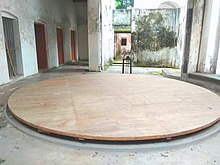| Muktagacha Zamindar Bari | |
|---|---|
| Native name Aat Ani Zamindar Bari (Bengali) | |
 | |
| Location | Muktagacha, Mymensingh, Bangladesh |
| Coordinates | 24°46′09″N 90°15′18″E / 24.769299°N 90.255052°E / 24.769299; 90.255052 |
Muktagacha Zamindar Bari (Bengali: মুক্তাগাছার জমিদার বাড়ি) or Aat Ani Zamindar Bari is an ancient zamindar palace located in Muktagacha Upazila of Mymensingh District, Bangladesh. The zamindar of Muktagacha was given the title of first Raja and then Maharaja by the British Raj, so the zamindar's residence was called Rajbari.
History
Zamindar Acharya Chowdhury founded the city of Muktagacha. Acharya Chowdhury clan founded the city and settled here. Shri Krishna Acharya Chowdhury, the first male of the Acharya Chowdhury clan, was a resident of Bogra. He was working in the revenue department at the Durbar of Murshidabad. He was a very confidant of the Nawab. He was working in the revenue department at the Nawab's court in 1132 at that time.
After the end of Palashi War in 1757 AD, due to various reasons, the four sons of Shri Krishna Acharya Chowdhury decided to come to Alapsingh from Bogra. These four sons of Shri Krishna Acharya Chowdhury are Ramram, Harram, Vishnuram and Shivaram. Before settling, they visited various places in this pargana and decided to settle in the present Muktagacha area. At that time there was not much population in Alapsingh pargana.
Hareram is one of the zamindars of Muktagacha. This Hareram house is now the Rajbari. Mezzo son of Srikrishna Acharya Chowdhury, the founder of Muktagacha zamindari. The zamindar of this clan is known as the zamindar of the Atani house. Atani Jagat Kishore Acharya Chowdhury had a reputation. Jagat Kishore has 4 sons Jitendra, Birendra, Nrisingh and Bhupendra Kishore Acharya Chowdhury. Jeetendra Kishore's son is Jivendra Kishore Acharya Chowdhury.
Architecture

Muktagacha's zamindari is 16 in total. 16 zamindars ruled here. There is a huge gate at the entrance of Muktagacha Rajbari. Built on an area of about 100 acres, this royal palace is a unique example of ancient architecture.
Revolving theater

Mymensingh has a long tradition of muktagacha plays. The cultural scene here was once very diverse. There was spontaneous participation of Muktagacha zamindars in drama, literature, culture etc. And this revolving stage made the drama more popular. Kumar Bhupendra Kishore, son of Zamindar Jagatkishore Acharya Chowdhury, was fond of drama. The stage was built as Bhupendra Rangapeeth after Bhupendra Kishore. It was the first such stage in Asia outside Kolkata.
Gallery
See also
References
- "Muktagacha Zamindar Bari: A palace in ruins for lack of care". The Daily Star (Bangladesh). 3 November 2023. Archived from the original on 23 July 2024. Retrieved 17 August 2024.
{{cite news}}: CS1 maint: bot: original URL status unknown (link) - সিদ্দিকী, বেনজীর আহমেদ (19 February 2022). "মুক্তাগাছায় এক চক্কর". Prothom Alo (in Bengali). Archived from the original on 17 August 2024. Retrieved 17 August 2024.
- "MuktagachHa Zamindar Bari: A palace in ruins". The Daily Star (Bangladesh). 4 November 2023. Archived from the original on 4 November 2023. Retrieved 17 August 2024.
- "How long will we ignore our heritage?". The Daily Star (Bangladesh). 7 November 2023. Archived from the original on 25 December 2023. Retrieved 17 August 2024.
{{cite news}}: CS1 maint: bot: original URL status unknown (link) - "মুক্তাগাছার রাজবাড়ি". muktagacha.mymensingh.gov.bd (in Bengali). Archived from the original on 2022-06-22. Retrieved 2024-08-17.
{{cite web}}: CS1 maint: bot: original URL status unknown (link) - জনকণ্ঠ, দৈনিক (13 January 2017). "মুক্তাগাছা জমিদারবাড়ি". Daily Janakantha.
- "মুক্তাগাছার জমিদারবাড়ি ও মণ্ডা". Protidiner Sangbad (in Bengali). 18 April 2022. Archived from the original on 17 August 2024. Retrieved 17 August 2024.
- "ইতিহাস-ঐতিহ্যের সাক্ষী মুক্তাগাছার রাজবাড়ি". The Financial Express (Bangladesh) (in Bengali).
- "মুক্তাগাছা জমিদার বাড়ির ইতিহাস শ্বেত পাথরে". Dhakatimes News (in Bengali). 9 September 2017.
- "ছবিতে মুক্তাগাছার জমিদার বাড়ি". banglanews24.com (in Bengali). 10 November 2017. Archived from the original on 17 August 2024. Retrieved 17 August 2024.
- "বিলুপ্তির পথে মুক্তাগাছা জমিদার বাড়ির ঐতিহাসিক নিদর্শনগুলো". RTV Online (in Bengali). 1 November 2020. Archived from the original on 18 May 2021. Retrieved 17 August 2024.
- "মুক্তাগাছায় শশীকান্তের রাজবাড়ি". banglanews24.com (in Bengali). 6 September 2013. Archived from the original on 17 August 2024. Retrieved 17 August 2024.
- "মুক্তাগাছার জমিদার বাড়ি (ভিডিওসহ)". bdnews24.com. 17 March 2023. Archived from the original on 24 July 2023. Retrieved 17 August 2024.
- "আসল চেহারায় ফিরেছে মুক্তাগাছা জমিদারবাড়ি". The Daily Ittefaq. 4 February 2022. Archived from the original on 10 March 2022. Retrieved 17 August 2024.
- প্রতিবেদক, নিজস্ব (25 September 2017). "মুক্তাগাছার জমিদারবাড়ি". Prothom Alo (in Bengali). Archived from the original on 17 August 2024. Retrieved 17 August 2024.
- "জমিদার নেই, আছে বাড়িটি". ajkerpatrika.com (in Bengali). 30 November 2021. Archived from the original on 20 January 2022. Retrieved 17 August 2024.
- "ঘুরে আসুন মুক্তাগাছা জমিদারবাড়ি". Samakal (in Bengali). 28 August 2019.
External links
 Media related to Aat Ani Zamindar Bari at Wikimedia Commons
Media related to Aat Ani Zamindar Bari at Wikimedia Commons












